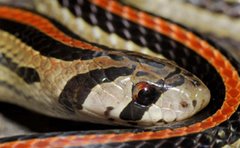We have been calling this beautiful snake the wrong name.
This elegant-looking snake that we have been calling Elegant Bronzeback (Dendrelaphis formosus) actually does not have a name until 18 January 2007 (Vogel & Rooijen, 2007). It is now named as Kopstein's Bronzeback (Dendrelaphis kopsteini), after Dr Felix Kopstein (1893-1939). This newly-described species is thus different from Elegant Bronzeback, which is also found in Singapore.
"What's in a name? That which we call a rose by any other name would smell as sweet" Juliet Capulet said. Kopstein's Bronzeback is still an elegant snake even if it is not named as "Elegant Bronzeback" after all.
The snake identified in Lim and Lee (1989) and Lim and Lim (1992) as Elegant Bronzeback (Dendrelaphis formosus) should be renamed as Kopstein's Bronzeback (Dendrelaphis kopsteini).
This elegant-looking snake that we have been calling Elegant Bronzeback (Dendrelaphis formosus) actually does not have a name until 18 January 2007 (Vogel & Rooijen, 2007). It is now named as Kopstein's Bronzeback (Dendrelaphis kopsteini), after Dr Felix Kopstein (1893-1939). This newly-described species is thus different from Elegant Bronzeback, which is also found in Singapore.
"What's in a name? That which we call a rose by any other name would smell as sweet" Juliet Capulet said. Kopstein's Bronzeback is still an elegant snake even if it is not named as "Elegant Bronzeback" after all.
The snake identified in Lim and Lee (1989) and Lim and Lim (1992) as Elegant Bronzeback (Dendrelaphis formosus) should be renamed as Kopstein's Bronzeback (Dendrelaphis kopsteini).


REFERENCES
Lim, F. L. K. & Lee, M. T. M., 1989. Fascinating Snakes of Southeast Asia – an Introduction. Tropical Press, Kuala Lumpur, p. 53.
Lim, K. K. P. & Lim, F. L. K., 1992. A Guide To The Amphibians & Reptiles Of Singapore. Singapore Science Centre, p. 64.
Vogel, G. & Rooijen, J. V., 2007. A new species of Dendrelaphis (Serpentes: Colubridae) from Southeast Asia. Zootaxa 1394: 25-45.
Lim, F. L. K. & Lee, M. T. M., 1989. Fascinating Snakes of Southeast Asia – an Introduction. Tropical Press, Kuala Lumpur, p. 53.
Lim, K. K. P. & Lim, F. L. K., 1992. A Guide To The Amphibians & Reptiles Of Singapore. Singapore Science Centre, p. 64.
Vogel, G. & Rooijen, J. V., 2007. A new species of Dendrelaphis (Serpentes: Colubridae) from Southeast Asia. Zootaxa 1394: 25-45.
















